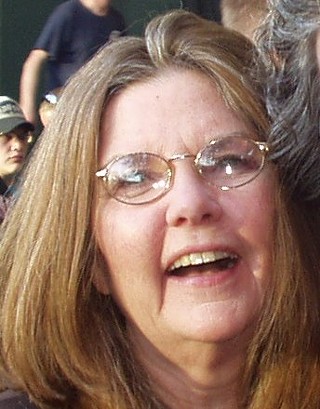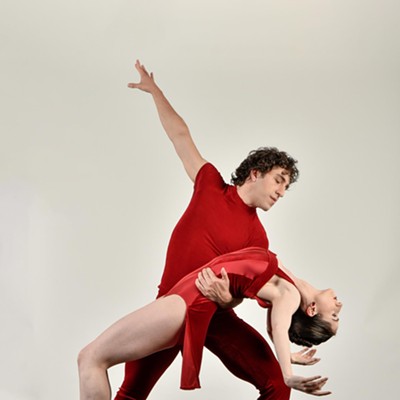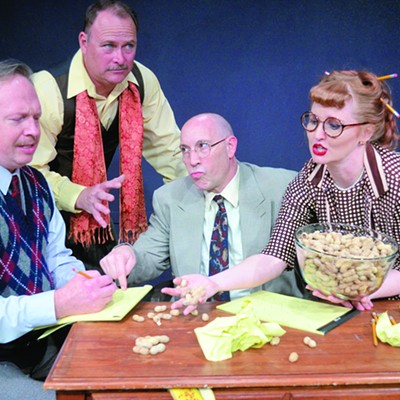It's Friday, the 13th of March, and Joey Burns has suggested we meet at the Lucky Strike Bowl. (Get it?) He watches for me from the lane he's reserved, his red leather-ish bowling bag propped next to him. If Stereogum can interview John Darnielle of Mountain Goats at a wrestling match, why not? I'm wondering just how strong is the noise reduction in my hand-held digital recorder. Instead he agrees to migrate to the quieter, dimly lit booths of the empty bar, red curved and channeled, resistant to any and all spills. We order ... wait for it ... White Russians.
"I think that people are the greatest fun" Love
This is how he suggests our story begin, "Overlooking the beautiful view that is Lucky Strike. On Friday the 13th." The word "fun" comes up three dozen times over the next hour.
He's over the moon, of course, about spending time at home with his wife and young twin daughters. And he's in love with being a dad. He's particularly in love with watching them discover music. He tells, for instance, of a time his sister played the video of Mark Ronson and Bruno Mars' "Uptown Funk" for the girls. They loved the song, a fun enough discovery, but a new epiphany came later via KXCI.
"(The DJ) played a whole wide range of music and there was this great shift between, like, vintage punk rock to this song," Burns says. "And one of my daughters comes in and goes 'I know this song! Daddy, I know this song!" Imagine thinking you'd never hear a song again.
Fatherhood's been full of such reminders of childlike wonder. "I think it's opened me up a lot," Burns says. "I think it's grounded me a lot."
Longtime collaborator Craig Schumacher of Wavelab Studios agrees. "It's this renaissance you can see. Whether it's Nova (Burns' wife) and the babies, I don't know, but it's like the level of maturity that he's showing is to me is a big leap forward. The song content really is much more grounded."
Schumacher's referring to Calexico's eighth studio release, "Edge of the Sun," due out Tuesday, April 14. It's the band's widest-ranging set, and a star turn for Burns' finest instruments: his taste and his ear. It's also a tribute to the inspiration and chemistry of everyone involved.
Collaborators included Ben Bridwell of Band of Horses, Iron & Wine's Sam Beam, Neko Case, Eric Burdon of War, Pieta Brown and artists like Amparo Sanchez and Carla Morrison, both popular wherever Spanish is the dominant language. Also included is Gaby Moreno, a newer Latina singer on the scene, who will open for Calexico on tour. Ten of the record's guest artists are featured in a “Mixtape” Calexico created for SPIN magazine.
“One of the reasons I like Anti Records is that they’re really big on collaborating,” Burns says. “I just enjoy it. It keeps things fresh and keeps things fun.”
Out of the void, chaos
“I’d left home (for) Auckland, New Zealand and when I got to the hotel I had written the song,” Burns says, embarking on a discussion of “Edge’s” opening track, “Falling from the Sky.” What ensues is a chronicle of the random inspirations, happy accidents and connections that go into a Calexico song.
“A lot of it was kind of informed by some of the phrasing of a children’s book called ‘House in the Night.’” He quotes the book, by Susan Marie Swanson, from memory, until the relevant cadence is clear. It’s his favorite book to read to the girls.
The song’s lyrics were honed, as were others, in several long-distance confabs with his brother John, a Silicon Valley techie with a degree in rhetoric from the University of California, Berkeley.
“It was fun,” Burns says, “to kind of cook things up with somebody like that on email or pick up the phone and we’re both walking our dogs. I’ll say, ‘Well, here are some ideas,’ and then we’ll kind of carve out something together.”
As Burns and other musicians, serially and collectively, from near and far, created parts and variations, an idea from an unexpected source yielded a transcendent result.
“Part of it is just being thrilled that someone like Ben Bridwell (of Band of Horses) would even be open to singing on that song,” Burns says. “Joe Novelli actually suggested that. Next I knew an email appeared from Ben saying, ‘Hey, I hear you’re trying to get hold of me.’” Unlike Neko Case, who laid down vocals live for the album’s NSA-tinged beauty “Tapping on The Line” during a Tucson stopover with the New Pornographers, Bridwell recorded layered harmony parts at home and emailed them in.
“I still haven’t met him yet,” Burns says. “How awesome is that? “It’s fun, you know, it’s all about the little gifts and things that come along the way. And sometimes they can be just as simple as finding a really nice kernel or motif of the guitar and then you grow the title and the general theme. Whatever process of the record it is, those beautiful surprises happen.”
Some surprises are bigger than others; John Convertino’s drums aren’t on this track, and it was he who urged that the song be released with Wavelab engineer Chris Schultz’ percussion from the original scratch demo. And although Calexico’s horn players later added highlights, Sergio Mendoza plays the lead-in and outro horn parts with the “horns” in his keyboard.
“We rarely go in with demos of the songs.” Burns says. “We tend to just write in the studio. Or in this case, write and record demos in Mexico City or Coyoacán. With ‘Falling From the Sky’ we couldn’t get a better take in Tucson. We were trying but we were thinking too much. There was something really spontaneous and loose about the original take and what was done in Coyoacán so we decided to keep it.”
Schumacher says, “Joey works his ass off the entire recording process to the point that everything he’s ever recorded—he has more mp3s in his laptop than anybody can even comprehend. Tons of versions he’s fallen in love with different aspects of.” It falls to Schultz to store and manage all that. “Without Chris’ due diligence in keeping track of all their files, they’d have been fucked. And you can put that in writing. “It’s 36 whatever amount of songs in Mexico City, Wavelab, the rehearsal space—shit was coming at us from everywhere and all the people sending us files. Chris kept backups of all that stuff.”
Like Burns, Schumacher thrives in the process. I need a nap after just hearing about it.
“You know, trying not to overthink things,” Burns says. “Just let things flow. Let the ideas come out, and then just sit back and allow yourself to listen, and just try to get the best performances that you can.” The result of all the layering and stripping away of different ideas, times and places is a new favorite Calexico song, equal in power and pace to “Crystal Frontier,” but with the jet-stream propulsion of an airplane ride on wings of hope. The only thing crystalline about it is the purity of its pop drive—the last thing anyone expected to come from Mexico.
Inside the box, outside the comfort zone
Sergio Mendoza (of Orkesta Mendoza) took charge of the expedition across the border and, over time, much more.
“I got really involved in the production in April of 2014. Joey said ‘Hey Sergio, I really want to collaborate with you, write some songs together.’ Even though I play in the band with them and I have been with them for close to eight years, it’s still intimidating to think of a setting where I’d be writing a song together with Joey, because I have a lot of respect for him musically and as a person.”
In Burns’ mind, though, Mendoza had the exact perfect setting—a studio in the historic Coyoacán district of Mexico City, near the headquarters of Hernán Cortez, and around the corner from the Blue House made famous by Frida Kahlo. It was Fresno Estudio, owned by Mendoza’s friend Ro Velazquez, whom Burns had met in 2013 when Mendoza produced Velazquez’ album in Tucson. Mendoza and Velazquez had met through their mutual friend, activist Camilo Lara of Mexico Institute of Sound.
“Ro invited everyone to stay at his house in Mexico,” Mendoza says, “so from that point on there was just me kind of helping make it all happen.” Mendoza, Burns and Convertino stayed 10 days.
Calexico had previously journeyed after inspiration, but not that far. The entire band gathered in Bisbee to sketch much of the music for the 2008 release, “Garden Ruin.” Burns, Convertino and Schumacher sojourned to New Orleans to launch the creative process for 2012’s “Algiers.”
Asked how displacement like that affects Calexico music, that stuff we most associate with the Sonoran Desert vibe, Convertino says, “I’ve heard Joey respond to this a lot. He kind of feels like it really doesn’t matter. You could be anywhere. And I agree with him to a certain degree, but I think musicians have a certain kind of antenna-like quality to them where they pick up vibrations from where they are.
“Really, it was different because so much of what Joey and I do, we work off of tones and how we sound in the room and how we sound to each other. We didn’t have that happening down there. That was more like a workout session in a small demo studio.”
Forced into a box outside of their geographic comfort zones, they discovered some new sounds, and originated some of the most diverse music in the band’s catalog. “Edge of the Sun” is uncommonly varied in its tempos, instrumentation and lyric content.
“Maybe because Ro’s writing pop-rock songs all the time, it’s like the vibration of him being in there, doing that, we picked up on that,” Convertino said.
That turned out to be a very good thing, underscoring the extraordinary diversity in Mexican music beyond the traditional sounds in the terroir.
The Calexico delegation nevertheless left Mexico with a stellar, almost fully realized instrumental, “Coyoacán,” that benefitted uniquely from contributions by guitarists and a Jalisco-harp player who were born to music most often associated with Mexican culture. Guitarrón parts were added back in Tucson by Mariachi Luz de Luna’s Antonio Pro. In an email, Mendoza elaborated on what his role in the process meant to him. “These guys have written beautiful music both in Americana and indie rocker styles, but they have also done a lot for Mariachi music. They don’t just play Mariachi, but take it to another level.”
In retrospect, the Mexico stay also inspired a new favorite cumbia, “Cumbia de Donde.” It’s a gypsy’s song, a migrant’s song, even a touring musician’s song of optimism made rash by desperation. It’s an affirming anthem for anyone headed to a new life in which loss is certain, and value merely an expectation, with hope strong enough to get them over the line.
Bullets and rocks
“I really love ‘Bullets and Rocks,’” says Schumacher of the second track on “Edge of the Sun.” “I think that’s some great writing.” He should know, having worked with Richard Buckner, Neko Case, Sam Beam, Tom Russell and Amos Lee, among others. Burns was in all of those sessions. “Bullets and Rocks” is Burns’ most explicit story yet about the vicissitudes of migration, a topic Calexico music revisits regularly with detailed expressions of the emotional binary: despair and empathy. The song “Crystal Frontier” responds to Carlos Fuentes’ high-contrast chiaroscuro novel about the chasm of class and the racist infrastructure in maquiladora culture. Luís Alberto Urrea’s Pulitzer Prize-winning “The Devil’s Highway,” detailing the long horrible deaths of real people who crossed the U.S.-Mexico border seeking a better life, informs a half-dozen of Burns’ lyrics, as does Urrea’s “Across the Wire: Life and Hard Times on the Mexican Border,” a gritty expose of refugees living on the edge. A Calexico song takes its title from “Across the Wire.” “Edge of the Sun” is dedicated to the late Chuck Bowden, an angry poet embedded in Mexico’s drug wars. Burns’ own passion for his border home, the good, the bad and the ugly, burns throughout the music of Calexico. He tells the world about it all, a prophet with a beautiful noise.
“You know Joey’s always taken Arizona issues and border issues seriously,” Schumacher says. “In the past it could’ve been a little paraphrased. He may have understood it better than he wrote it. I think with ‘Bullets and Rocks’ he’s synthesized what’s going on worldwide, whether it’s Palestinians or it’s here or wherever it is. He’s really putting himself out there in a good way, and I don’t see a lot of other artists besides Neko right now taking social causes to heart. “
Burns says of “Bullets and Rocks”: “It’s all accumulated, from Gaza to Tucson. Everywhere you go, so many incidents have occurred over the years.” He offers an anecdote of his own as an example of universal border tension. “We had an incident where we were driving in a bus with a trailer, leaving Calais going to the UK from Dover. We stopped for gas and the bus driver noticed that the lock on the trailer was broken. So he rolled forward to the customs and immigration officers and said, “I think that somebody has jumped into our trailer.” They checked and they found some people that had come from, I think, Iraq. And they wanted to press charges on the bus driver!
“There are so many complications. We’ve seen it locally and read about it internationally.”
Edge of the Sun
As a family man and a touring musician, Burns is viscerally familiar with dichotomies. He also loves one of the most complicated borders in global geography, one that separates people from bright promise, or darkest danger, even death. He’s confident, though, in his own forward motion. He aims, always, for the sun. It rhymes with fun. “I’m very genuine with who I am. I’m not trying to come off as something that I’m not. Listen to the music. Read the lyrics or see the band perform live. I think the most important thing that we can all do is live by example.”
Perhaps the example he sets best is that of hope for the future. “I think we’re starting to get more involved in many different things (affecting) the community, reaching out to others in need. I think it’s important for us to reach out, and, definitely, Tucson is a community that can’t hold back that kind of feeling and compassion and empathy.” As in the closing lines of “Falling From the Sky,” Burns believes “Clouds will be breaking, soon you’ll escape them/Someday we’ll find our place in the sky.”












